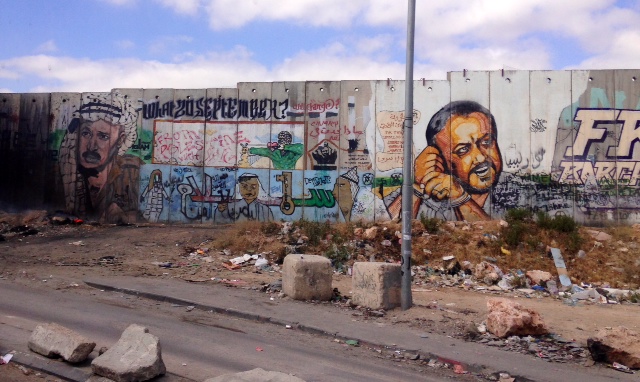Nobel Literature Prize winner J.M. Coetzee spoke in Ramallah recently as part of the Palestine Festival of Literature, an event I cannot recommend following and (if you are as lucky as I was a few years ago) participating in enough.
The Palestine Museum -- a new museum that should open in Birzeit in 2016 -- has created a collection of images that mash up contemporary photographs with Baroque religious paintings. (Another series, also at this link, juxtaposes photos from the refugee camps today and decades ago).
The Deposition (c. 1507) Raphaello Sanzio da Urbino
Photo: Israeli soldiers kill a Palestinian and detain others, downtown Ramallah. 31 Mar. 2002
byAlexandra Boulat
The second installment of my diary of the Palestine Festival of Literature went up at Bookforum over the weekend:
The daily life of Palestinians is constrained by an intricate complex of physical and bureaucratic barriers. Nowhere are the divisions and inequalities more dramatic than in Hebron. In 1994, after a far-right Israeli named Baruch Goldstein opened fire in the Ibrahimi Mosque that surrounds the patriarch Abraham’s tomb and killed twenty-nine Palestinians, the holy site was divided into a mosque and a synagogue. Muslims and Jews look at the same tomb from separate barred windows, bullet-proof partitions between them. Four hundred ultra-Orthodox settlers live in the city proper, alongside nearly 200,000 Palestinians. To accommodate and protect them, the government has shut down the main commercial thoroughfare, putting thousands of people out of work. Billboards explain that the street was closed due to the violence of the Second Intifada. Fifteen years on, settlers harass Palestinians, throwing bleach on the wares of shops and attacking children on their way to school. While we holders of foreign passports make our way past checkpoints down the ghostly street, Palestinians must take a much longer and more circuitous route to get from one side of the city to the other.
In a place this segregated, one is forced take sides. (The Jewish or the Muslim entrance? The settler road or the one open to Palestinians?) By the end of the week everyone at Palfest is overwhelmed, not just by the touring schedule and the flow of dispiriting details, but by the constant effort of positioning oneself—one’s work, one’s words—in relation to this terrible, lopsided fight.
The first installment is here. I also wrote something on all the lines that criss-cross Israel-Palestine (segregating Israelis and Palestinians, but also dividing Palestinians from each other, and from their Arab neighbors) for Mada Masr.
Below is a performance by the very talented British-Egyptian playwright and poet Sabrina Mahfouz, who composed this after a visit to Hebron and performed it two days later in Ramallah:
All last week I was traveling through the West Bank with PalFest. It was an exhausting, moving, enlightening experience. I was introduced to many great writers, poets and performers and to half a dozen cities: Ramallah, Jerusalem, Bethlehem, Hebron, Haifa, Akka and Nablus. I've written a diary of the trip for Bookforum; the first of two installments is here.
Graffiti on the wall of a community center in Hebron
June 1
We’re on the move again. Because so many Palestinians can’t travel, Palfest brings writers from around the world to them. And because Palestinians can’t even move freely from one West Bank city to another, the festival travels every day, to reach as many people as possible.
We take the Qalandia Crossing from Ramallah to Jerusalem. After passing through the checkpoint’s narrow metal chutes and heavy turnstiles, we emerge on the other side of the giant cement wall that Israel began building twelve years ago, and that zig-zags across the West Bank. The Iraqi writer Haifa Zangana is reminded of checkpoints in Baghdad, and marvels at how easy it is to “make things familiar that are unacceptable.”
Jerusalem’s Old City is beautiful and bitter. Little by little, day by day, its Muslim residents are stripped of land and homes and residency permits. Israeli settlers have occupied about eighty buildings in the Muslim and Christian quarters, covering them in flags and barbed wire.
In the evening, on the esplanade of the Burj Al-Luqluq Social Center, the local poet Najwan Darwish reads from his collection Nothing More to Lose, recently published by NYRB Classics. His poem “Jerusalem (I)” opens:
“We stood on the Mount
to raise a sacrifice for you
and when we saw our hand rise
empty
we knew
that we were your sacrifice”
The reading is nearly drowned out by the sound of nearby fireworks, set off to celebrate a neighborhood resident’s release from prison.
Ramallah
Approaching the Qalandiya Crossing into Jerusalem (the only entrance for Palestinians on foot), graffiti of Yasser Arafat and jailed leader Marwan Barghouti
The crossing
Author Teju Cole photographs the wall
Jerusalem. A beautiful but sad city, in which every inch is being bitterly fought for. Many individual houses in the Old City's historically Muslim or Christian quarters have been "settled," occupied by Israelis who drape them in flags and barbed wire.







